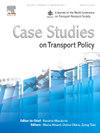A Data-Driven framework for predicting ship berthing time and optimizing port operations at Tan Cang Cat Lai Port, Vietnam
IF 2.4
Q3 TRANSPORTATION
引用次数: 0
Abstract
This study explores the use of machine learning models to predict ship berthing time (SBT) at Tan Cang Cat Lai port (VNSGN) in Vietnam, identifying Random Forest as the most effective approach. Comparative evaluations of models, including LSBoost, Decision Trees, ANN, CART, Ridge Regression, and Elastic Net Regression, highlight Random Forest’s superior performance with the lowest MAE (1.33), MSE (3.66), and RMSE (1.91), along with the highest R2 (0.84) and accuracy (69.17%). Feature importance analysis reveals cargo volume (35.3%), deadweight, and weather conditions as critical factors influencing SBT. The model demonstrates a strong ability to predict high-demand periods when berth congestion and cargo inflow are highest. By leveraging these insights, ports can optimize berth scheduling, resource allocation, and operational workflows, reducing vessel idle times and improving efficiency. Additionally, the use of predictive tools like Random Forest (RF) supports sustainable logistics by minimizing fuel consumption and greenhouse gas emissions. This research highlights the potential of data-driven approaches in maritime logistics, offering actionable strategies to enhance operational performance, reduce costs, and achieve sustainable port development. The findings provide a foundation for further advancements in predictive modeling for port operations.
预测船舶靠泊时间和优化越南Tan ang Cat Lai港港口操作的数据驱动框架
本研究探索了使用机器学习模型来预测越南Tan ang Cat Lai港(VNSGN)的船舶靠泊时间(SBT),并将随机森林确定为最有效的方法。通过LSBoost、Decision Trees、ANN、CART、Ridge Regression和Elastic Net Regression等模型的对比评估,突出了Random Forest的优异性能,其最低的MAE(1.33)、MSE(3.66)和RMSE(1.91),以及最高的R2(0.84)和准确率(69.17%)。特征重要性分析显示,货运量(35.3%)、载重和天气条件是影响SBT的关键因素。该模型具有较强的预测泊位拥塞和货运量最高的高需求期的能力。通过利用这些见解,港口可以优化泊位调度、资源分配和操作工作流程,减少船舶闲置时间并提高效率。此外,随机森林(RF)等预测工具的使用通过最大限度地减少燃料消耗和温室气体排放来支持可持续物流。这项研究强调了数据驱动方法在海上物流中的潜力,为提高运营绩效、降低成本和实现可持续港口发展提供了可行的策略。研究结果为港口运营预测建模的进一步发展奠定了基础。
本文章由计算机程序翻译,如有差异,请以英文原文为准。
求助全文
约1分钟内获得全文
求助全文

 求助内容:
求助内容: 应助结果提醒方式:
应助结果提醒方式:


